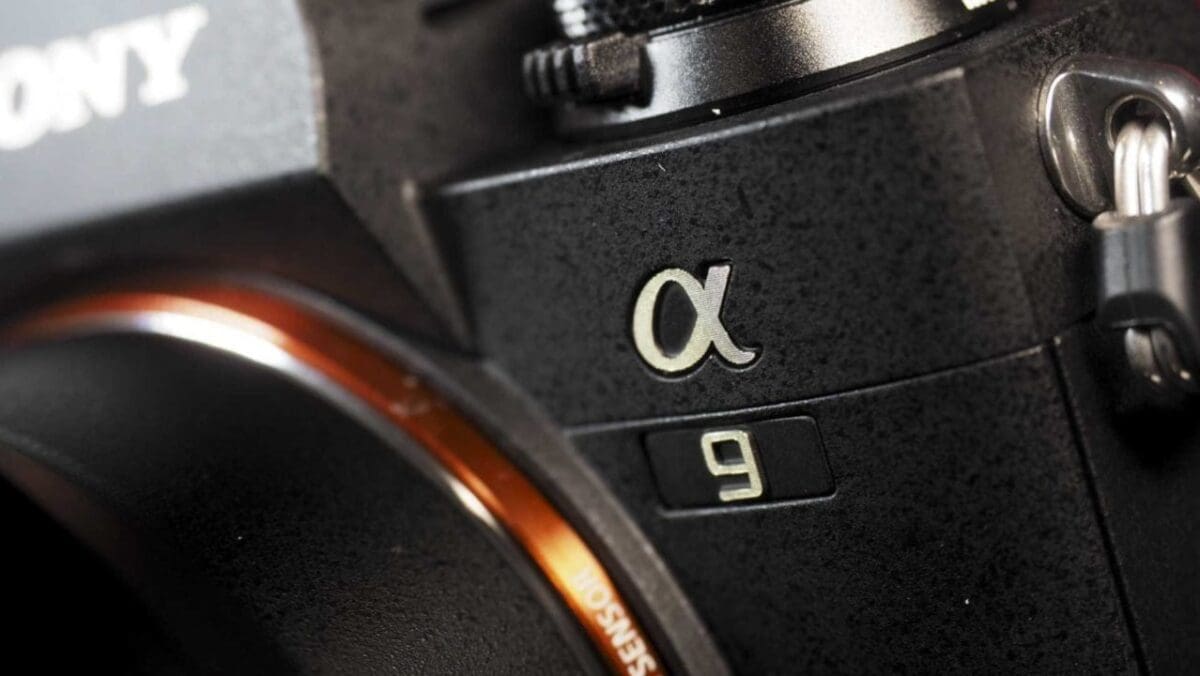Snap Verdict
Sony has introduced the Alpha 9, also know as the A9, at the top of its compact system camera line-up, above the A7 II, A7S II and A7R II.
It has a full-frame sensor CMOS with a stacked design and an effective pixel count of 24.2 million. That may sound fairly standard these days but its 693-point wide area phase detection autofocus (AF) system and 20 frames per second shooting capability are anything but. The huge number of AF points mean that the A9 can track subjects across almost the entire frame, very close to the edges.
Combine this fast, accurate focusing capability with silent shooting and a readout speed that avoids rolling shutter problems at 20fps and you have a professional-level camera that can deliver images that are simply not possible with other models.
Key features
- Date announced: 19th April 2017
- Price at launch: £4,5000/$4,500 (body only)
- Sensor size: Full-frame (35.8 x 23.9mm)
- Effective pixel count: 24.2 million
- Processor: Bionz X supported by memory integrated into the sensor
- Lens Mount: Sony E (FE)
- Viewfinder: 0.5-inch type OLED with 3,686,400 dots:
- Sensitivity range: ISO 100 – 51200 (expandable to ISO 50 – 204,800 with the mechanical shutter or ISO 100 -25,600 (ISO 50) with the electronic shutter
- AF system: 693-point wide area phase detection AF
- Monitor: Tilting 3-inch LCD with 1,440,000 dots
- Max shooting rate: 20fps with AF & AE tracking for up to 241 raw or 362 jpeg images
- Max video resolution: 4K (3840 x 2160) at 30p, 100M
- Storage: Dual card slots, Slot 1: SD(UHS-I/II compliant), Slot 2: Memory Stick Duo/SD (UHS-I)
- Dimensions: 126.9 x 95.6 x 63.0mm / 5 x 3 7/8 x 2 1/2 inches
- Weight: 673g / 1 lb 7.7 oz with battery and card
Sony’s A7-series of compact system cameras is credited with kickstarting the mirrorless camera market in regions that had previously seemed pretty disinterested in the technology. The first generation which includes the Sony A7R, A7S and A7 caused a sensation because of their small size and full-frame sensors, not to mention their relatively affordable prices. Then the second generation, the Sony A7R II, AS II and A7 II, came along ironing out some of the handling issues and offering yet better specifications to make them even more enticing despite their higher prices.
Both generations were aimed at the enthusiast and professional market but now Sony has introduced the Alpha 9 which is aimed at professional photographers and is designed to compete with the Nikon D5 and Canon 1DX Mark II. Accordingly it has an impressive specification and Sony has used what it’s learned from the two A7-series generations to enhance the handling.
Sony A9 Sensor
Inside the Sony Alpha 9 is a 24.2Mp full-frame CMOS sensor with a stacked design and integral memory. The stacked structure keeps the circuitry out of the way, maximising the space available for the photoreceptors (aka pixels) to increase their light gathering capability and help keep noise at bay.
With this in mind Sony has given the A9 a standard sensitivity range of ISO 100 – 51,200 and an expanded range of ISO 50 – 204,800.
Like the Sony A7R II, A7S II and A7 II, the A9’s sensor can move to facilitate the 5-axis image stabilisation and help keep images sharp as light levels and shutter speeds fall. The stabilisation system has a claimed hand-held shutter speed extension of 5EV, that’s the difference between 1/250sec and 1/8sec.
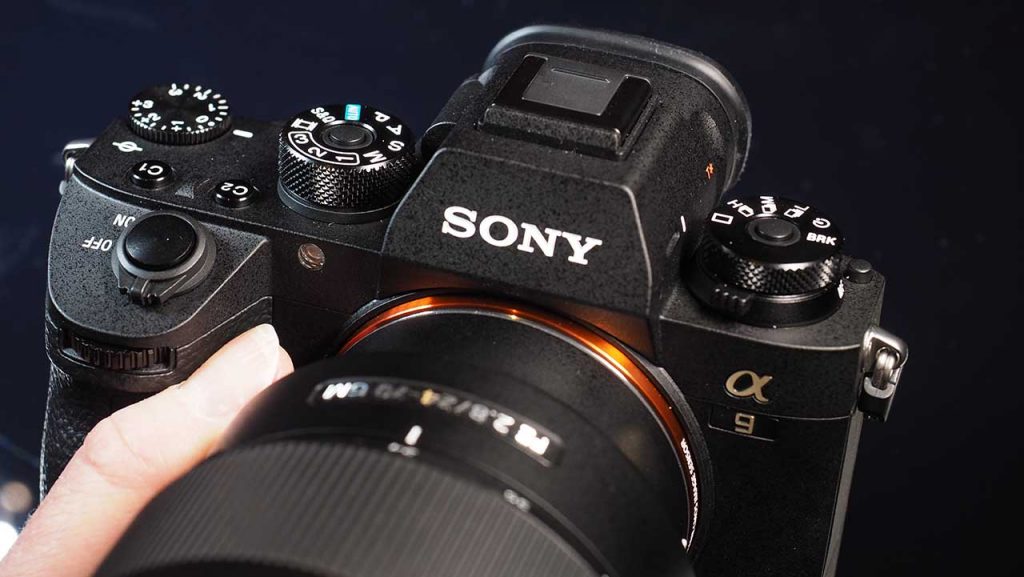
Sony A9 Continuous Shooting
The sensor’s integral memory works in tandem with the Bionz X processor to enable faster data readout. As a consequence the Sony A9 has a full resolution maximum continuous shooting rate of 20fps (frames per second), that’s with continuous autofocus and metering. That blistering pace can be maintained for up to 241 raw files or 362 jpegs – equating to roughly 12 seconds shooting continuously in raw format or 18 seconds in jpeg format, so you should able to capture every fleeting expression on a top-class 100m sprinter’s face from the gun firing to the finish line and still have some capacity for the winner’s celebration.
It’s interesting that Sony has opted for two SD card slots with only one being UHS-II compatible and the other UHS-I. We might have expected an XQD slot to accept the faster media, perhaps boosting burst depth even further.
Shutter options
The Sony Alpha 9 has both an electronic and a mechanical shutter, it needs to use its electronic shutter to record images at 20fps, the mechanical shutter is limited to 5fps. The shutter type can be set via the menu but if you select the Auto shutter selection option the camera will automatically opt to use the electronic shutter when it’s set to High Continuous Shooting.
Sony has complimented the 20fps continuous shooting capability with a top shutter speed of 1/32,000sec with the electronic shutter. This can also be completely silent which makes it possible to shoot sport in situations that are currently forbidden in major tournaments – during the serve in tennis and the swing in golf for example. Actually being able to use a camera in those situations at major tournaments will take agreement from the governing bodies but according to Sony Europe’s Vice President and Head of Digital Imaging Group, Yosuke Aoki, that is all up for discussion. If Sony achieved such an agreement photographers using the A9 would gain a significant advantage over Canon and Nikon users.
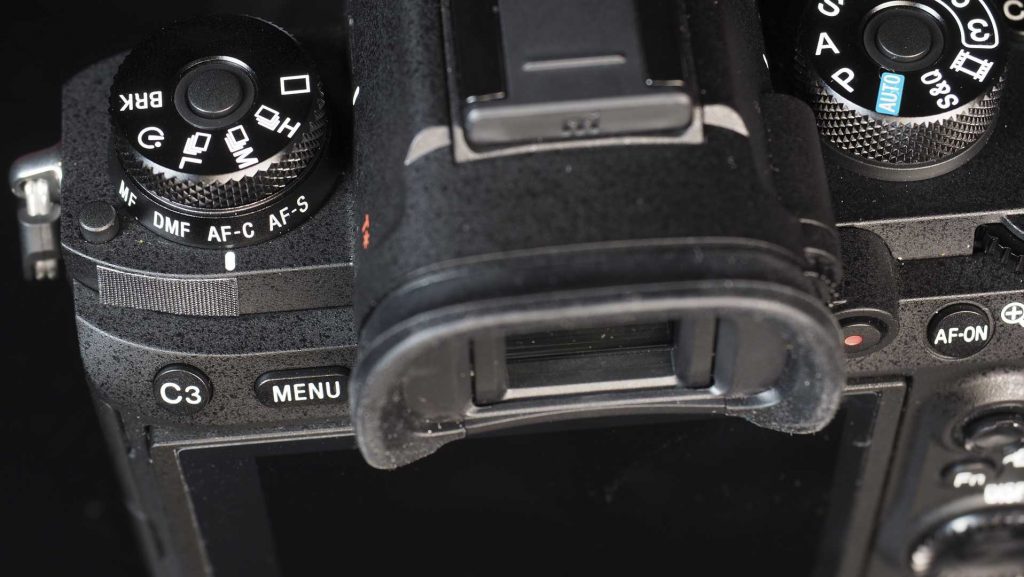
Sony A9 AF system
Of course, Canon 1DX Mark II and Nikon D5 users would demand a high specification autofocusing system to be persuaded to convert to the Alpha 9. Sony has given it a 693-point wide area phase detection autofocus (AF) system with an additional 25 contrast detection points. The 693 points cover approximately 93% of the scene, giving unprecedented coverage in a full-frame camera and enabling the A9 to track subjects close to the edge of the frame.
Thanks to the sensor’s faster readout the Sony A9’s AF system is able to calculate focus and exposure up to 60 times per second. At 20 frames per second means 3 times per shot and it contributes the delivering fast, accurate focusing.
It’s also possible to adjust the tracking sensitivity of the autofocus across 5 steps. The highest setting, 5, is the most sensitive and is intended for use when subject distance is likely to change quickly. The lowest setting, 1, is the least sensitive and should be used when you want the camera to ignore objects coming between the camera and the subject.
There are eight modes for the autofocus system: Wide, Zone, Center, Flexible Spot, Expand Flexible Spot and Lock-on AF (in continuous focus mode) along with Face Detection and Eye AF mode. Each determines which focus points are available for selection. Follow the link below to read more about how and when to use the these AF settings and how the Sony Alpha 9 AF system performs.
Sony A9 Viewfinder
As it’s a compact system or mirrorless camera the Sony A9 has an electronic viewfinder (EVF) rather than an optical one. When electronic viewfinders first appeared they were pretty terrible but they’ve come a long way. The 0-5-inch OLED unit in the A9 has 3,686,400 dots and 0.78x magnification along Zeiss T* coatings to keep down reflections and a fluorine coating on the outer lens to help keep dirt at bay. What’s more as it has a maximum refresh rate of 120fps there’s no noticeable lag – the refresh rate drops to 60fps when you’re shooting at 20fps.
Like other EVF’s the A9’s is capable of showing the image as it will be captured, taking onto account white balance, exposure and colour settings. And when the electronic shutter is in use there’s no blackout which means that you can follow moving subjects easily.
I found the Alpha 9’s EVF provides a very clear, natural view that is sure to convince EVF-haters that they are the future for photography. The colour and exposure are also a good match for the captured image.
Sony A9 Screen
Like the EVF, the 3-inch 1,440,000-dot touchscreen on the back of the camera provides a good clear view. The tilting mechanism which allows it to be tipped up through 107 degrees or down by 41 degrees is also useful when you’re shooting low or high-level landscape format images. A fully-articulating screen would be even better as it would be helpful with portrait/upright format images.
In addition, the screen is responsive to touch, but Sony has limited its use to just setting AF-point and zooming in and out of images in review mode. It would be nice to be able to use it to navigate the menu and make setting selections as well. Following a conversation I had with Sony Europe’s Vice President and Head of Digital Imaging Group, Yosuke Aoki, I’m hoping that this might come with a firmware upgrade. Fingers crossed!
Sony A9 Video
Sony is totally on-board with 4K video so naturally the Alpha 9 is capable of recording footage at 3840 x 2160. It does this with full pixel readout and no pixel binning, oversampling at 6K for high-quality 4K output.
Good news for slow motion lovers is that the A9 can record Full HD at 120fps at up to 100Mbps, enabling 4x or 5x slow-motion playback. It’s an enticing option.
Further good news is that thanks to the high-speed readout of the sensor, rolling shutter is also minimised and there are headphone and microphone for better sound monitoring and recording.
There is, however, a significant disappointment with the A9’s video capability, there are no Picture Profiles or S-Log modes. Again I’m hopeful that these will be added with a firmware upgrade as Yosuke Aoki said that Sony would listen to opinion and prepare firmware upgrades accordingly.
Sony A9 Battery life and connectivity
With electronic viewfinders and permanent live view Sony A7 cameras are power-hungry so their batteries don’t last very long. Sony has given the Alpha 9 a new larger battery with a life of 480 shots when the EVF is in use and 650 shots with LCD. When shooting continuously I found I got far more images than that from a single charge but it would still be advisable to have an extra battery or two for prolonged shoots.
As it manufacturers smartphones and tablets, it’s no surprise that Sony has given the A9 Bluetooth, NFC and Wi-Fi connectivity. It can also be paired with a phone running Sony’s PlayMemories Mobile app to receive location data, tag images and correct the camera’s date, time and location settings.
Showing its pro-level credentials, the A9 has a terminal for a wired LAN connection. This enables still images to be transferred quickly to a specified FTP server. The files can also be encrypted with SSL or TLS while being transferred if security is an issue.
It’s good to also see a sync port for connecting studio flash units.
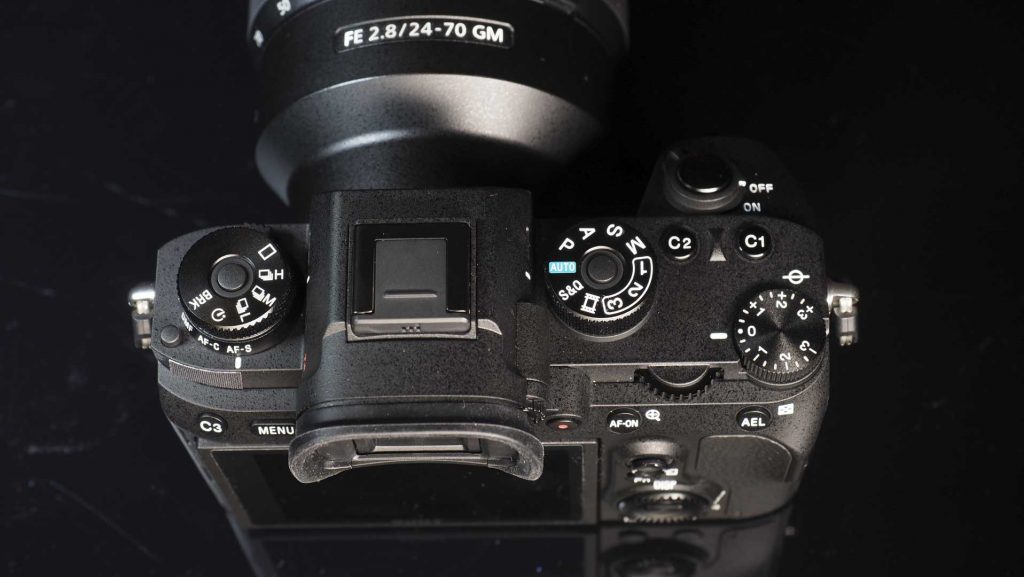
Sony A9 Build and Handling
The Sony Alpha 9 is only a little bigger than the Sony A7R II, but it feels more robust and solid. We’re told that the body panels have tongue-and-groove joints to ensure they interlock tightly while seals around the buttons, dials and media port cover help keep out dust and moisture.
Unlike Canon and Nikon’s flagship cameras, the Sony A9 doesn’t have a vertical grip built-in, but there’s an optional Vertical Grip (VG-C3EM) for around £330/$348 if you need one. The standard grip is deep and comfortable to use with standard focal length lenses but bigger optics tip the balance somewhat. That said, I didn’t have much difficulty using the A9 with a Canon 100-400mm lenses mounted via a Metabones adaptor.
Paired with a Sony FE 70-200mm f/4 G OSS the A9 feels good in your hand and you have powerful tool that’s smaller and lighter than a comparable DSLR.
Control Layout
While there are lots of similarities with the Sony A7 II (and Sony A7R II and A7S II) there are a few differences too. One of the most obvious differences is the introduction of two stacked dials on the left of the top-plate. The lower dial is released by a button just to its left and allows you to set the focus mode. The locking button makes it a little on the fiddly side to use, but it’s not too bad. Above it is the drive mode dial, which has a central button that must be pressed before it can rotate.
Over on the right of the top-plate is a familiar mode dial with the usual advanced exposure mode options (program, shutter priority, aperture priority and manual) along with an Auto setting, three custom settings and two video modes – one standard and one S&Q (slow and quick) option for shooting slow and quick motion footage.
One change that I’m particularly pleased about in comparison with A7 series cameras is the location of the video record button. Instead of sitting on a corner of the camera so you have to readjust your grip and wobble the camera every time you press it, this is on the back of the A9 to the left of the AF-on button and within easy reach of your right thumb.
New Joystick control
Another significant introduction is the mini-joystick on the back of the camera that allows you to navigate menus and set AF point quickly – hurrah! I found it a real bonus when using the viewfinder – especially given the wide coverage of the AF points. It falls conveniently under your thumb and is nice and responsive.
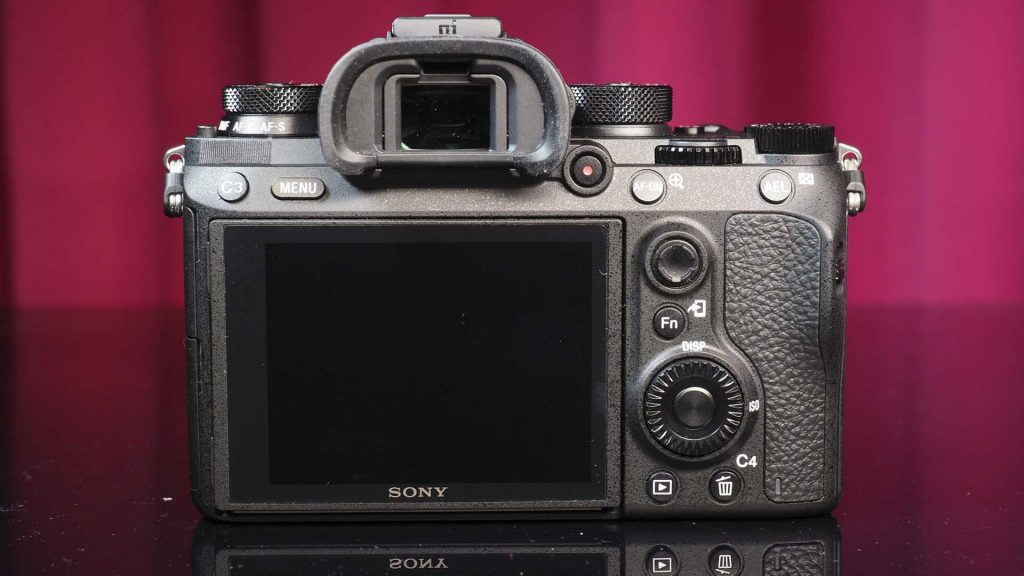
Silent Shooting
When all the sounds are turned off and the electronic shutter is in use the Alpha 9 is silent, not just quiet – silent. There’s only the flickering of AF frame to let you know that you’re actually shooting. While it’s extremely useful in some instances, it’s also a little unnerving and I’m pretty sure I’m not the only photographer who occasionally opted to turn the sound on just to have the reassurance that it brings.
Customisation
As with other recent Sony cameras, it’s possible to customise the A9, but Sony has extended what’s possible in comparison with previous models. There are three custom shooting modes on the mode dial for example, rather than the two that are found on the Sony A7 II series. These enable you switch shooting mode and an extensive array of settings with just a turn of the dial.
I found the default set-up of the Alpha 9 works well, it certainly makes a good starting point, but nine of the buttons, plus the control wheel and three of the navigation pad buttons can be customised to reach the features you use most often. Of these buttons, four are dedicated custom buttons and there’s a total of 69 functions available to be assigned to them. That means you’re unlikely to hit the optimal set-up for the camera the first time you use it and it’s worth experimenting to find what works best for you.
As we’ve come to expect from Sony mirrorless system cameras, the A9’s menu is extensive – the first section of the shooting menu covers 13 screens while the second covers 9 and the set-up section has 7 pages. Follow this link to see the full collection of Sony Alpha 9 menus along with some product images.
It takes time to find the option you want and become familiar with the arrangement. Thankfully there’s a My Menu option to which you can assign up to 30 features for quicker access. It’s worth noting here that none of the features listed in the Playback menu nor the ‘View on TV’ option can be assigned to My Menu.
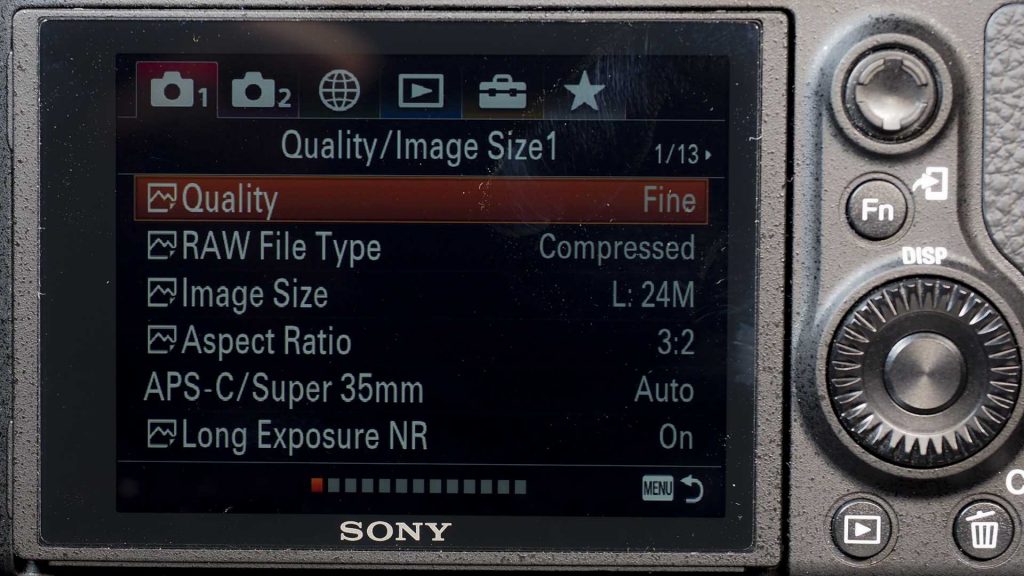
Sony A9 Performance
As it has 24 million pixels rather than the 42 million pixels of the Sony A7R II, the Alpha 9 is never going to match the older camera for detail resolution, but the image quality is still high with fine details being recorded well even at sensitivities as high as ISO 6400 and 12,800. Noise is also controlled well at these values with jpegs having no sign of speckling and raw files having a fine texture visible at 100% on screen.
At ISO 6400 the difference between raw and jpeg files at 100% on-screen is very subtle. As I’ve mentioned, raw files have a slight texture and there’s just a touch more detail. However, in the default settings the jpegs have slightly more micro contrast which enhances the impression of detail.
It’s when you shoot with it that you notice the real difference between the A9 and the A7RII. The focusing is fast, really fast. And when you’re shooting at 20fps there’s no blackout, so you can keep the subject in the frame easily.
The first time I shot with the Sony A9 was at its launch and checking the EXIF data reveals that 28 minutes passed between me taking the first and last shots. During those 28 minutes I shot a total of 921 images with the majority being fired-off at 20fps. There were many breaks in shooting in that time while we moved between the different shooting scenarios, waited for the action to start, the boxing partners to change or I checked shots on the back of the camera etc. That gives you a taste of how many images it’s possible to rack-up when you’re shooting at such a high frame rate.
Autofocus performance
The launch was in a boxing gym with constant lights set-up to allow movement-freezing shutter speeds of 1/1000sec and 1/1600 sec to be used at a sensitivity setting of ISO 1600. The smallest aperture I used was f/6.3, with many being at f/2.8 and f/4 so the relatively restricted depth of field makes the success or failure of the AF system fairly obvious.
With two boxers in the frame when I was using Wide AF mode, the focusing system tended to select one (not always the nearest) and stick with them. If one boxer obscured the other, the AF system would switch subject and it didn’t leap onto the background. On some occasions, it homed in on the gloves – often the brightest part of the scene.
My next shooting opportunity with the Sony Alpha 9 was on a trip to Northumberland where I used it to photograph seals, puffins and landscapes as well as my puppy getting his first taste (literally) of a beach. I’ve written a separate post (see below) about using the Sony A9 to photograph birds, but suffice to say that the autofocus (AF) system made it extremely easy to photograph them in flight.
Continuous Autofocus
In continuous AF mode the A9 is quick to latch onto moving subjects and it follows them with apparent ease.
I normally shy away from settings that give a camera free rein to determine the AF point to use but the A9 performed superbly in Wide AF mode even when there was a cluttered background such as cliffs or rocks behind the moving birds. When I was using continuous AF mode to photograph my dog on the beach, I noticed that if he was still the camera sometimes focused on a point a little closer to me than he was, but as soon as he started moving it snapped onto him. If he ran towards me his head got the AF system’s attention, if he ran away it was his backside.
Again shooting at 20fps meant I racked up a lot of files and I was grateful for the 3TB WD My Passport Wireless Pro to store images and free-up my SD cards out in the field.
Exposure
As a mirrorless camera the A9 uses the imaging sensor to assess exposure. In the boxing gym the A9’s Multi-segment metering did a very good job of getting exposure right and even managed to deliver correctly exposure images when shooting a small subject against a very bright background.
I used the exposure compensation control quite frequently when I was shooting in Northumberland but there weren’t any surprises about when it was needed. And as the A9 operates in full-time live view mode I could see what was required in the viewfinder. When shooting a dark subject on a beach with very light coloured sand, or with the bright sea in the background for instance, I increased the exposure by around a stop (1EV) to get the detail of the subject. In some cases I needed to brighten the subject a little more and darken down the background (there was usually still plenty of tonal gradation), but this was a moment’s work with the raw files in Adobe Camera Raw.
On a few occasions I reduced the exposure by 0.3, 0.7 or even 1EV to get more detail in the sky with the intention of brightening the foreground or the raw file in post-production, again this takes just a few moments in Adobe Camera Raw.
Dynamic Range
The A9 has good dynamic range which means the images have a wide range of tones and have lots of scope for post capture adjustment. I was able to successfully brighten a dark low sensitivity image by as much as 5EV and still get good detail and colour.
In natural light in its Standard Creative Style and Automatic or Daylight white balance settings the Sony A9 produces attractive, natural colours that aren’t quite as vibrant as from some cameras but still look good. Switching to the and skin tones that reflect those of the subjects. If you want a bit more saturation, the Vivid Creative Style is available but I generally find it a bit strong for my taste.
The automatic white balance setting also seems to do a reasonable job in artificial light but I haven’t tested this aspect extensively.
Sony A9 Verdict
Professional cameras tend to specialise and concentrate on fairly limited area of photography. As a professional-level camera the Sony Alpha 9 has an extensive feature set and there’s a huge range of customisation options. The optimum set-up is likely to vary from photographer to photographer and it’s only through shooting the same subject on a frequent basis that you’ll find the find the arrangement that works best for you.
However one thing is for sure, the Sony A9 is a fantastic camera. Its fast, clever autofocus system makes photographing tricky subjects like birds in flight a cinch while its electronic viewfinder allows you to be confident that you’ve got the result you want as you shoot. With a good quality lens like the Sony FE 70-200mm f/4 G OSS mounted, the level of detail in images is superb and thanks to the full-frame sensor, f/4 is wide enough to isolate your subject from its background. Noise is also controlled well and raw files have plenty of latitude for adjustment.
Sony’s lens range is growing, and there are more lenses in the pipeline, but given the intended market of the A9 it needs more long, fast lenses soon. If you’re shooting still or slow moving subjects a mount adaptor such as those offered by Metabones will help you plug the focal length gaps (and keep cost down), but if you want to shooting moving subjects you need Sony lenses. The Sony FE 100-400mm F4.5–5.6 GM OSS Super Telephoto Zoom (model SEL100400GM) that was launched with the A9 seems very good, but it lacks the fixed wide aperture that many pros want.
Lens issues aside, the Sony A9 is certain to give Canon and Nikon cause for concern, it really is a game changer.
[FAG id=31571]

